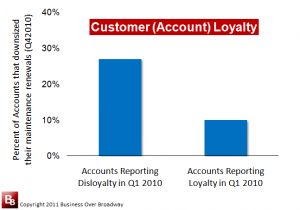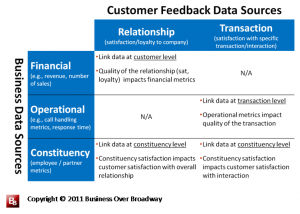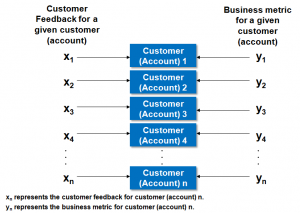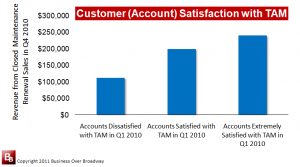Business linkage analysis is the process of linking disparate business data sources together for the purposes of understanding the relationships between them (See Figure 1). For financial linkage analysis, we are interested in understanding the relationship between customer feedback metrics and financial business outcomes. Demonstrating the statistical relationship between customer feedback metrics and financial business outcomes is useful for three reasons:
- Strengthen business case for your VOC program: Demonstrating your customer feedback metrics predict future bottom line metrics shows executives that tracking/measuring customer satisfaction/loyalty is important business metrics. Senior executives’ support of the VOC program is paramount to its success, and a customer-financial linkage can quickly illustrate the reasons why you have a customer feedback program and the important business outcomes it predicts.
- Identify drivers of real customer behaviors: In typical VOC programs, we measure customer loyalty via survey questions that let customers indicate their future loyalty behaviors (recommend, buy again, not churn). Using linkage analysis, we can use real customer loyalty behaviors in our analysis. Taking this approach, we can understand drivers of real customer behaviors (number of products purchased, sales amount).
- Determine ROI for customer experience improvement solutions: Improving customer loyalty may require significant investment to improve the customer experience. Financial linkage analysis can help you understand the expected increases in financial performance given a specific improvement in customer satisfaction.
Financial and Customer Feedback Metrics
I use the term, “financial metrics,” to include various types of business outcomes that can be used in linkage analyses. These metrics include:
- Customer tenure
- Customer defection rate
- Number of new customers
- Revenue
- Service contract renewal
- Number of sales transactions
- Number of products purchased
- Frequency of purchases
It is important to note that the specific details of conducting linkage analyses may vary slightly for different metrics; The level at which the financial metric can be summarized (by geography, by time, by customer) reflects the level at which the datasets need to be merged. If you are able to track revenue for each customer, you can associate the customer feedback metric with each customer’s revenue. On the other hand, if you are able to track defection rate at the group level, you can associate the customer feedback metric with each group’s defection rate. The key here is to ensure the level of analysis (e.g., customer, geography, time-level) makes sense given the level of measurement of your financial metric.
in financial linkage studies, we use customer feedback metrics from a relationship-based survey where responses indicate general levels of satisfaction and loyalty toward the company. Additionally, it is important to note that these customer feedback metrics need to be from respondents who are responsible for, or have an influence in, purchasing decisions. Customer feedback metrics from relationship-based surveys could include loyalty questions/indices or satisfaction with business attributes (customer experience).
Linking Financial Metrics to Customer Metrics
Once we have these two sources of business data, we organize the data so that each customer (or group or time period) has a score on the financial metric and the customer feedback metric. The example in Figure 2 represents the linkage at the customer level (For a B2B example, the merging can occur at the Account level). For each customer (account), we have two pieces of information, customer feedback (x) and a business outcome (y).
Loyalty metrics are forward looking (e.g., likelihood to behave in certain positive ways in the future). As such, financial linkage analysis needs to involve loyalty metrics measured at one time (Time 1) and financial metrics measured at later time (Time 2). The nature of the regular sales cycle will have an impact on loyalty behaviors, so careful thought needs to be given to the length between the two time periods.
Results

Figure 3. Relationship between Customer Satisfaction with Technical Support and Maintenance Renewals
The output of the analyses will illustrate the relationship between customer satisfaction/loyalty and business outcomes. When presenting the results of the analysis, I like to illustrate the relationship in graphical form. Below are two figures that show the relationship between customer satisfaction/loyalty metrics and important business outcomes.
Figure 3 illustrates the relationship between customer satisfaction with technical support and downsizes in maintenance renewals. We found that accounts who are dissatisfied with technical support in Q1 2010 are more likely to result in downsizes in maintenance renewals for Q4 2010 compared to accounts who are satisfied with technical support in 1 2010.
Figure 4 illustrates the relationship between customer satisfaction with technical account managers (TAMs) and revenue. Accounts that are more satisfied with Technical Account Management (TAM) performance in Q1 2010 have significantly higher revenue from maintenance renewals in Q4 2010 compared to account that are dissatisfied with TAM performance in Q1 2010.
Using the results of these analyses, senior executives were able to estimate the increased revenue they would expect (additional revenue and saved revenue) given improvements in customer satisfaction.
Summary
Financial linkage analysis helps show the consequences of customer satisfaction and loyalty and demonstrate the value of the VOC metics. In my examples, the linkage analyses showed us that customer feedback metrics (customer satisfaction with tech support and satisfaction with technical account managers) were, in fact, predictive of future business metrics (maintenance renewals and revenue, respectively).
Next week’s blog will be dedicated to illustrating linkage analysis using operational metrics and customer feedback metrics.






